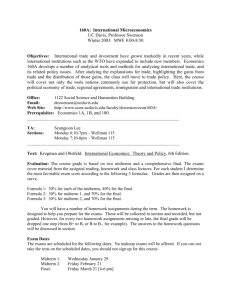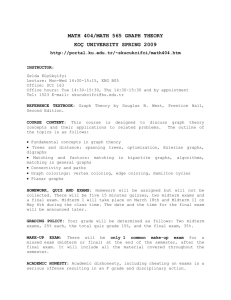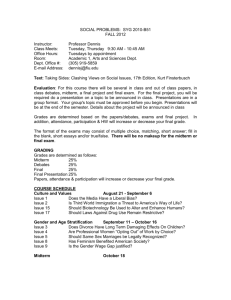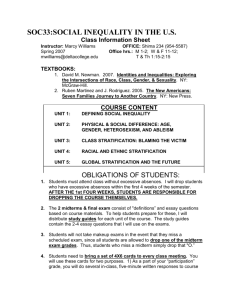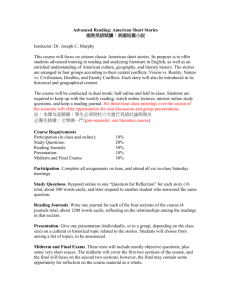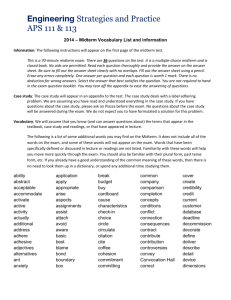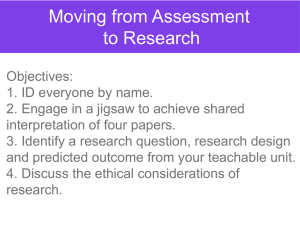Document 8991578
advertisement
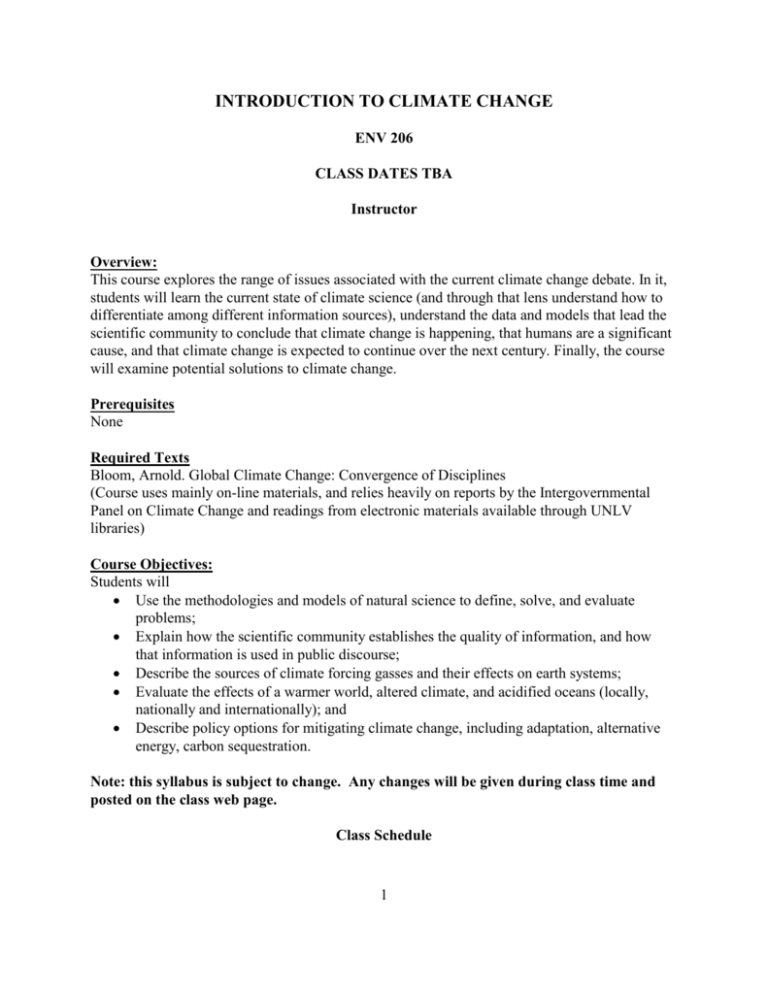
INTRODUCTION TO CLIMATE CHANGE ENV 206 CLASS DATES TBA Instructor Overview: This course explores the range of issues associated with the current climate change debate. In it, students will learn the current state of climate science (and through that lens understand how to differentiate among different information sources), understand the data and models that lead the scientific community to conclude that climate change is happening, that humans are a significant cause, and that climate change is expected to continue over the next century. Finally, the course will examine potential solutions to climate change. Prerequisites None Required Texts Bloom, Arnold. Global Climate Change: Convergence of Disciplines (Course uses mainly on-line materials, and relies heavily on reports by the Intergovernmental Panel on Climate Change and readings from electronic materials available through UNLV libraries) Course Objectives: Students will Use the methodologies and models of natural science to define, solve, and evaluate problems; Explain how the scientific community establishes the quality of information, and how that information is used in public discourse; Describe the sources of climate forcing gasses and their effects on earth systems; Evaluate the effects of a warmer world, altered climate, and acidified oceans (locally, nationally and internationally); and Describe policy options for mitigating climate change, including adaptation, alternative energy, carbon sequestration. Note: this syllabus is subject to change. Any changes will be given during class time and posted on the class web page. Class Schedule 1 Week 1 2–5 6–7 8 - 10 11 – 13 14 – 15 Topic Part I: Overview Introduction to climate change: History Current state of the science Current state of the policy debate. Part II: Science of Climate Change: Data, theory, modeling and uncertainty How science works; understanding which claims are science Why science can be controversial (with sidetrips to Creationism and radioactivity) Accessing science – a trip to the library Systems Thinking The data: a warming planet (plus sea level rise, acidifying oceans) The theory: the Greenhouse Effect Energy: The elephant in the room The conclusion: anthropogenic climate change MIDTERM I Part III: Effects of climate change Deciding what to count Effects to date: local, national, international Predicted effects Part IV: Mitigating climate change The “do nothing” option Balancing objectives: energy and economy Energy alternatives Carbon sequestration, renewables, the nuclear debate Conservation and efficiency Transportation, Building, Manufacturing, Agriculture Adapting to a warmer world MIDTERM II Part IV: Policies, politics Decision making under uncertainty National Politics and Climate Change California, Massachusetts v USEPA, political debate International Politics and Climate Change Before, during and after Kyoto, the China Challenge Climate and conflict: fresh water, sea level rise, energy resources An aesthetic of climate consciousness? Part V: Wrapping Up The Wedge Game Student presentations FINAL EXAMINATION, Time TBA 2 CLASS POLICIES Grading: Each student can earn as many as 100 total points in this class: 50 from midterm exams, 30 from the final exam, 10 for in-class participation and 10 for presentations. Final grades will be based on the following scale. A = 100 – 92 points, A- = 90 –91 points, B+ = 88 – 89 points, B = 87 – 82 points, B- = 80 – 81 points, C+ = 78 – 79 points, C = 77 – 71 points, C- = 70 points, D+ = 68 – 69 points, D = 67 – 60 points, F = less than 60 points Exams: Midterm I will cover material from weeks 1 – 5; Midterm II will cover material from weeks 6 – 10 (although you will quickly see that weeks 6 – 10 build on 1 – 5), and the Final Exam will be cumulative. Participation: Discussing the readings during each class session is a significant part of learning in this course. Students are expected to complete the readings before class, and have some questions/comments prepared. The in-class participation portion of the grade will be based on completing classroom exercises during class time; students will need to come to class prepared as directed during the semester Students Presentations: Students will present in-depth discussions of some aspect of climate science or policy that interests them. Details on this will be provided after the second Midterm. Disabilities: If you have a documented disability that may require assistance, you will need to go to the Disability Resource Center (DRC) for coordination of academic accommodations. The Disability Resource Center is located in the Reynolds Student Services Building room 137. The DRC phone number is 895-0866 (TDD-895-0652) or drcssc@ccmail.nevada.edu. Withdrawals: Withdrawals from the course are possible through the date specified in the Fall 2001 Catalog. Until then you may drop with no questions asked. After that date, withdrawals are not permitted for any reason. Incompletes: I will give an incomplete in the course if, for some reason beyond your control (hospitalization, death in the family) you cannot complete the course. Under no circumstances will you be given an incomplete because you are failing. How can I do well in this course ? Success in college, as in much of life, requires that you plan ahead. In college, planning requires that you are aware of your class schedules, and that your studying always prepares you for exams and assignments. I recommend that you pursue the following activities to be an active participant in your learning and to facilitate successful completion of your courses. Recall that for every hour you spend in class, you are expected to spend at least two hours outside of class reading, studying, or working on assignments; for summer session, this amounts to almost three and a half hours of studying per day. Make this a regular practice—not something you do 3 at the last minute or just before exams. 1) Attend every class meeting. This cannot be overemphasized. Take careful notes. Some students respond to the lack of roll call in college with sporadic attendance. Such action is academically suicidal. There is too much material in the textbook for everything to be on an exam; therefore, you must learn what the instructor=s emphasis is. You can only ascertain this by attending every lecture and taking down as much of the information presented in the lecture as possible. As a general rule: a good student will miss at most ONE class sessions, and then only in an emergency situation. 2) Obtain class notes on the Internet before class and annotate them during lecture. As an additional check, meet with classmates to compare notes several days before an exam. 3) Read the assigned material before coming to class. Textbooks should not be read like novels. When reading textbooks, emphasize the chapter outlines, headings and subheadings, material that is highlighted or enumerated, and figures. Read the summary, review questions, and key terms at the end of the chapter first. Next, skim through the chapter, reading only section headings and emphasized words. Then read lists, tables, and figures. Finally, read the chapter from start to finish. This reading method will take a few more minutes, but your comprehension and retention will be much better than with a straight read-through. 4) Recopy your notes. If your note taking is anything like mine, your notes will likely be a little disorganized, sloppy and incomplete. It is very important that, as soon as possible, you sit down and recopy the in-class notes into a neater, more comprehensible format for later study. Use the text and notes on the Internet as a reference to aid in rewriting lecture notes after class. Save your original notes for reference or emergencies, but study from your neat notes. Reorganization of notes is greatly facilitated by a computer, but rewriting by hand is also effective. Both sets should be stored safely in a binder or on a disc. 5) Study the recopied notes well before an exam (two weeks before a comprehensive final). This is where your calendar is very important. You should mark it with not only the exam dates, but also with the Abegin study@ dates. Study should not be a passive re-reading, but a very active process during which important headings and concepts are marked, and perhaps rewritten. Highlighter pens, colored pens, and colored pencils can all be employed to help make the process active and conceptually supportive (by linking concepts and terms with similar inks or colors). 6) Obtain and fill out a calendar now. Assemble the schedule (syllabus) from each of your classes and enter important dates from each on the same calendar. Include the exam dates. This lets you know when to emphasize which class, day-by-day, week-by-week. Copyright and fair use requirements The university requires each member of the University Community to become familiar with and 4 follow copyright and fair use requirements. You are individually and solely responsible for violations of copyright and fair use laws. The University will neither protect nor defend you nor assume any responsibility for employee or student violations of copyright or fair use laws. Violations of copyright laws could subject you to federal and state civil penalties and criminal liabilities as well as disciplinary action under University policies. To help familiarize yourself with copyright and fair use policies, the University encourages you to visit its copyright web page at: http://www.unlv.edu/committees/copyright 5
